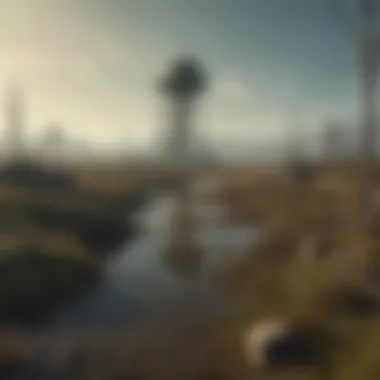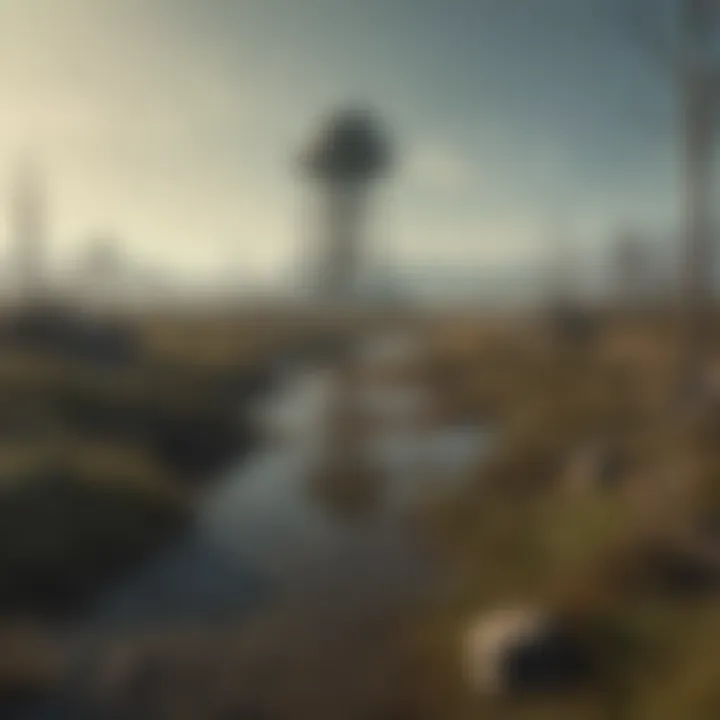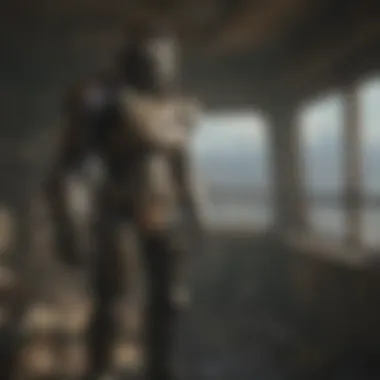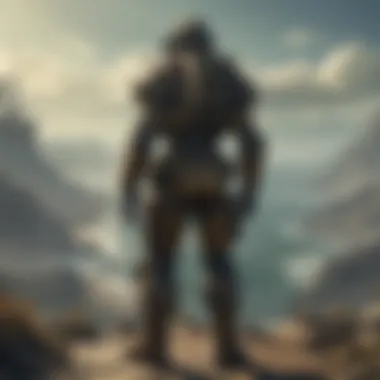Exploring PT Lookout: A Deep Dive into Fallout Lore


Intro
In the expansive realm of the Fallout franchise, few locations are as deeply layered as PT Lookout. This setting serves not merely as a backdrop for player exploration, but as a rich tapestry woven with lore, character, and gameplay dynamics. The peculiar ambience of a once-bustling tourist destination now tainted by the ravages of war offers a unique perspective on the Fallout universe.
Players often find themselves drawn into PT Lookout's eerie, swampy landscapes, home to a variety of engaging characters and quests. To fully appreciate this site, it is essential to understand its historical significance and thematic depth, as these elements enhance the overall experience within the franchise.
In this exploration, we will dissect PT Lookout's lore, gameplay tips, character narratives, and uncover how this location fits into the larger Fallout narrative. By the end, readers will garner a more profound understanding of what makes PT Lookout a standout destination in the Fallout series.
Preface to PT Lookout
PT Lookout represents a pivotal aspect of the Fallout universe. As an expansive area within the game, it provides players with not only a unique environment but also rich lore that enhances the overall narrative of the Fallout series. Its haunting landscapes and intricate backstory place it among the more memorable locations within the games. Exploring this area allows players to grapple with the remnants of human existence and the consequences of a world ravaged by nuclear devastation.
Overview of PT Lookout
PT Lookout can be described as a stern landscape depicting the aftermath of the Great War, situated in the area formerly known as the Virginia coast. This resort destination, once a thriving retreat, now serves as a backdrop for haunting encounters and desperation. The remnants of human leisure and aspiration are starkly contrasted by eerie sights and dangerous beings.
The geography includes marshlands, shrines, and abandoned structures. Players can wander through abandoned huts and dilapidated piers, each location telling a story of plenty before the apocalypse struck. This diversity in landscape not only enriches the immersion but challenges traversing the area, with the unique environment impacting gameplay mechanics, as players must navigate treacherous marsh conditions to uncover secrets hidden within.
Importance in Fallout Lore
In the broader context of Fallout lore, PT Lookout stands crucial. It signifies the contrast between pre-war flourishing and post-war decay. The many quests, characters, and interactions available in PT Lookout draw on themes central to the Fallout narrative, such as survival, resilience, and the complexity of human relationships in extreme conditions. The area is a microcosm of the universe's larger themes and serves as a reminder of the fragility of civilization.
Moreover, the quests present in PT Lookout tie directly into the motives and aspirations of its characters. Players experience this interplay first-hand, often experiencing moral dilemmas and choices that resonate through the game's overarching storyline. As players navigate this realm, they engage with its rich set of characters and stories, allowing for a deeper understanding of the ongoing impact of the Great War on humanity and its remnants.
"PT Lookout is not just a location; it is an exploration of human nature, the remnants of what we were, and what we could become."
Overall, the introduction to PT Lookout serves as a gateway into a complex world fraught with peril and discovery, compelling players to delve further into its dark narrative.
Geographical Features
Understanding the geographical features of PT Lookout is essential for appreciating the unique experiences it provides. The ecology and layout contribute to both the gameplay mechanics and narrative depth in Fallout. Players are not merely traversing a map; they engage with an environment that tells its own story. The landscape shapes player strategies and interactions with the inhabitants of PT Lookout, enhancing immersion.
Landscape and Environment
The landscape of PT Lookout is steeped in a post-apocalyptic aura marked by decay and isolation. From the initial approach, players encounter marshy wetlands, dense forests, and remnants of civilization. Sparse structures dot the landscape, often overtaken by nature.
The environment reflects themes of survival and abandonment. The murky waters and foggy valleys evoke a sense of mystery. This contributes to the overall lore, guiding players through the narrative while highlighting the harsh realities of life in the wasteland. The inclusion of various biomes, such as areas with higher elevation and water, requires adaptable gameplay strategies, emphasizing the need for resourcefulness.
Key Locations within PT Lookout
PT Lookout brims with notable locations that deepen the narrative connections within the Fallout universe. Key locations serve as focal points for quests and storylines, inviting exploration.
- The Ferris Wheel: A remnant of the past, it stands imposing yet forlorn. It elicits feelings of nostalgia and serves as a backstory for various quests.
- The Lighthouse: This structure acts not only as a landmark but also plays a significant role in the game's plot. Its connection to the local lore enhances the sense of discovery.
- The Smugglers' Hideout: A clandestine location that unveils the darker aspects of PT Lookout. Here, players encounter unique characters and make decisions that impact their journey.
Each location is carefully designed to weave into the overarching story and gameplay experience. Engaging with these sites rewards players with insights into the past and enriches the Fallout narrative.
"PT Lookout demands exploration. Each location unveils a layer of history that connects players to the wider Fallout world."
In sum, the geographical features of PT Lookout provide both a backdrop and a catalyst for player experiences. The unique landscape, coupled with significant locations, creates a rich tapestry of discovery and engagement.
Historical Context
Understanding the historical context of PT Lookout is crucial for comprehending its significance within the Fallout universe. This area is not just a backdrop for the game's events; it is a narrative device loaded with implications about the past, shaping both the player's experience and the broader lore of the franchise. By examining the history of PT Lookout, players uncover layers of storytelling that inform decisions and feelings when exploring this haunting landscape.
Pre-War Significance
Before the devastation of the Great War, PT Lookout was a popular tourist destination. It featured lush scenery and was known for its entertainment value. Families visited to enjoy the attractions, including amusement parks and recreational facilities. This period was marked by the thriving economy, where the local businesses flourished due to the influx of guests. Furthermore, PT Lookout's role as a retreat emphasized the pre-war society's values of leisure and escapism.
The region also reflected societal elements that contributed to the unfolding narrative in Fallout. At that time, tensions were high globally. While the townsfolk engaged in leisure, significant political and environmental issues loomed. This foreshadowed the societal collapse that would come with the war. Thus, the landscape carries memory and meaning, extending beyond its surface beauty to symbolize fragility in society.


Impact of the Great War
The Great War drastically transformed PT Lookout. Once a symbol of enjoyment and peace, the location turned into a desolate wasteland, littered with remnants of human activity and tragedy. The rapid annihilation left scars still visible to players navigating the ruins. This contrast enhances the sense of loss and serves as a backdrop for the struggles of survivors. The aftermath of the war is not merely historical; it creates existential questions about survival, morality, and the consequences of human actions.
Players discovering PT Lookout post-war encounter remnants of pre-war life. They witness the disintegration of a once vibrant society and grapple with the ghosts of its past. The factions and characters they interact with often hold onto their own narratives shaped by the war's destruction. Through this, PT Lookout emerges not only as a location but as a poignant reminder of human choices in the face of catastrophic consequence.
"PT Lookout represents the juxtaposition of beauty and decay, inviting players to confront their historical choices."
As players explore these themes, they enrich their understanding of the Fallout narrative. They see history as more than just a series of events; it becomes a lens through which personal and collective identity is forged. This depth of narrative elevates PT Lookout into a compelling chapter within the Fallout saga.
The Lore of PT Lookout
The lore of PT Lookout serves as the backbone of the experiences players encounter while navigating this unique locale. It intricately weaves narratives that elevate the understanding of the overarching Fallout universe, giving depth to the player’s journey. The choices made by players within PT Lookout are profoundly influenced by the lore surrounding various factions and the myths that permeate the region. This section will delve into the notable factions involved in the area, as well as the myths and legends that shape the player’s interaction with the environment. Understanding these elements enhances the immersive qualities of gameplay, inviting players to delve deeper into the setting’s narrative.
Factions Involved
PT Lookout features several factions that illustrate the complexity of the post-apocalyptic world in Fallout. Each faction presents its own set of challenges, rewards, and lore that players can explore. Notable factions in PT Lookout include:
- The Reality Stalkers: This group is heavily involved in various quests and interactions. They embody the desperation for survival that other factions also display. Their conflicting goals and practices provide tension within the story, forcing players to question their own morality.
- The Bog Loggers: A faction that thrives on the resources PT Lookout has to offer, the Bog Loggers function within a dynamic that highlights the environmental issues of the Fallout universe. Their struggle for power and control over resources reflects the larger themes of exploitation and survival.
- The Cultists: Bound by strange rituals and beliefs, the Cultists add an air of mystery to PT Lookout. They become central to the myths that surround the area, guiding player interactions and decisions involving them.
These factions contribute to the rich tapestry of PT Lookout's lore, giving players multiple perspectives on the realities of the post-apocalyptic world. The intricate relationships formed with these factions help players navigate their moral compass and alter the course of their stories.
Myths and Legends
Myths and legends create an undercurrent of intrigue within PT Lookout, serving as frameworks for player exploration and engagement. They reflect the culture and fears of the inhabitants before and after the Great War. Some significant myths include:
- The Legend of the Swamp Ghosts: Tales of ghostly figures haunting the marshes have made their way through the community. This myth serves not only to chill the spine but also to explain the strange happenings reported by travelers.
- The Fakestone: A supposed artifact rumored to grant wishes haunts the minds of locals and adventurers alike. This lore enriches the gameplay narrative, as players often seek the Fakestone's location amidst quests and pitfalls.
- The Tale of the River Spirits: Stories of benevolent spirits protecting the waters contribute to the environmental themes. These spirits symbolize humanity's lost connection with nature and pose questions about ecological consequences.
These myths and legends enhance the atmosphere of PT Lookout, prompting players to reflect on profound themes while navigating their quests. The blend of lore and gameplay creates a compelling tapestry that encourages exploration and deeper engagement.
Gameplay Mechanics
The gameplay mechanics of PT Lookout play a crucial role in defining the player's experience. This section not only reveals the intricacies that characterize quests and objectives but also introduces unique items and rewards that enhance gameplay. Understanding these mechanics is essential for players who want to navigate PT Lookout effectively and fully enjoy what it offers.
Quests and Objectives
In PT Lookout, quests and objectives serve as the backbone of player engagement. The main quest line leads players through a series of challenges that are tightly woven into the narrative. Each quest requires strategic thinking and decision-making, pushing players to explore various aspects of the environment and interact with NPCs.
Some notable quests include "A Meeting of the Minds", which challenges players to confront the mysterious nature of the region, and "The Tides of War", where moral choices heavily affect the outcome. These quests are not just tasks to complete; they invite players to immerse themselves in the rich lore while facing threats from local factions like the swamp folk and the bizarre Cerberus.
The structure of these quests encourages exploration. Players might stumble upon side quests that expand the overall experience. This method of quest design promotes a sense of discovery within the eerie landscape, making the gameplay feel organic and rewarding.
Unique Items and Rewards
PT Lookout is home to several unique items that players can acquire throughout their journey. These items not only provide practical benefits but also enrich the lore and atmosphere of the game. Players have the opportunity to obtain items like the valuable "Hunting rifle" or special ammunition types which can significantly enhance combat capabilities.
Other rewards include rare crafting materials and unique consumables that allow for strategic advantages in subsequent encounters. Items such as the "Dandy Boy Apples" or "Nuka-Cola Quantum" can be essential for survival and combat efficiency.
Each player's exploration is rewarded differently, depending on choices made throughout quests. For example, players who focus on dialogue and diplomacy may uncover unique paths that reveal hidden treasures. In contrast, those who favor brute force may miss out on more nuanced interactions and rewards.
As a whole, the unique items and rewards in PT Lookout contribute not just to character development but to a deeper connection with the world around. Players are often left with a sense of accomplishment when they discover these treasures, making the gameplay mechanics a vital aspect of the overall Fallout experience.
Characters of PT Lookout
Characters in PT Lookout play a crucial role in shaping the player experience and enriching the ongoing narrative of the Fallout universe. Each non-playable character (NPC) serves not just as a quest-giver or a source of information, but also adds depth through their individual stories and backgrounds. These characters reflect the themes of survival and the impact of the Great War, allowing players to engage with the consequences of the post-apocalyptic world. Understanding these characters brings intimacy to the gameplay environment and assists players in making moral choices.
Notable NPCs
PT Lookout introduces various NPCs, each adding distinct layers to the player experience. Some notable figures include:


- Desmond Lockheart: A former member of a pre-war elite, Desmond stands as a symbol of luxury and excess that contrasts starkly with the ravaged landscape of PT Lookout. His quests delve into the complex dynamics of power and morality, challenging players’ values.
- The Blind Dog: Serving as an oddity and a source of curiosity, this non-verbal character creates an unexpected emotional tie to the world, engaging players on a different level than typical NPC interactions.
- The Scavenger: This character represents the harsh reality of survival in PT Lookout. Through his attempts to navigate the dangers of the area, players are reminded of the precariousness of life amidst the chaos.
These NPCs are essential because they not only propel quests but also encapsulate the broader themes of the Fallout series, offering insight into the human condition in extreme circumstances.
Character Development Arcs
The development arcs of characters in PT Lookout showcase the stark contrast between past lives and current realities. By interacting with these characters, players witness incredible transformations that stem from the fallout of the Great War.
- Desmond Lockheart's Journey: Initially embodying privilege, Desmond’s downfall illustrates the fragility of societal structures. His descriptive dialogue gives players insight into his despair and regret, prompting contemplation about the value of wealth in a collapsed world.
- The Blind Dog's Role: This character's lack of verbal communication forces players to interpret actions over words. This unique dynamic adds a layer of depth to player interactions, as they learn to appreciate emotional contexts without traditional dialogue.
- The Scavenger's Struggle: Illustrating the grind of survival, this character's development mirrors common themes of hope and despair. Players see how choices affect his journey, reflecting on their decisions and the consequences right within the gameplay.
By analyzing these arcs, players can derive deeper meanings about morality, choices, and the human experience, which resonate beyond the surface gameplay, making PT Lookout a memorable and engaging experience.
Themes and Atmosphere
In examining PT Lookout, the themes and atmosphere present significant dimensions of the overall experience. They contribute pathways for players to engage deeply with the land. The blending of survival elements with the haunting isolation sets the mood. Atmosphere reaffirms the narrative, creating a space where every corner tells a story. Themes resonate uniformly across the gameplay, enriching the player's journey.
Survival and Isolation
Survival in PT Lookout is not just about resources but about grappling with the environment. Players find themselves in a post-apocalyptic world that emphasizes loneliness amidst danger. Here, survival might mean scavenging for food or avoiding the various threats lurking around. This sense of isolation emphasizes the individual struggle against the desolate backdrop of the region. The landscape, filled with wreckage and abandoned structures, reflects the fragility of human existence.
Players often encounter creatures and entities that enhance this feeling of isolation. For instance, the local fauna may attack unexpectedly, reminding players of their vulnerability. Scenarios designed in the game force players to continually adapt—or risk failure. This dynamic reinforces the importance of maintaining a strategic mindset while staying alert. The choices one makes can have life or death consequences, heightening the tension.
Morality and Choices
Morality within PT Lookout presents complex dilemmas that challenge the player’s ethical compass. The game is rife with choices that aren't merely binary. Each decision can lead to unexpected consequences, shaping the narrative in unique ways. Often, players may face situations that test their beliefs about right and wrong. This incorporation of morality enriches the storyline and encourages self-reflection.
Characters encountered in PT Lookout often exploit this theme. Some may present themselves as allies but harbor ulterior motives. Players must navigate these relationships carefully, weighing the risk of betrayal against cooperation. This brings a level of depth to character interactions that is both engaging and thought-provoking. The decisions made here can alter the environment significantly, ultimately affecting how the narrative unfolds.
Ultimately, the themes of survival, isolation, morality, and choices combine to create a rich tapestry that defines PT Lookout. Together, they build a compelling atmosphere that enhances the overall experience of exploration within the Fallout universe.
Visual and Audio Design
Visual and audio design play a crucial role in creating an immersive experience in PT Lookout. These elements not only enhance the atmosphere but also contribute to storytelling and gameplay engagement. By focusing on careful art direction and the integration of sound, the developers succeeded in establishing a haunting and captivating environment that resonates with players.
Art Direction
The art direction in PT Lookout reflects the eerie and desolate nature of the region. The choice of colors, textures, and overall design greatly influences the player’s perception of this area. Shades of green and brown dominate the landscape, suggesting decay and neglect. The abandoned buildings and remnants of past civilization provide a backdrop that tells a story of decline, contributing to the overarching theme of survival in a post-apocalyptic world.
In PT Lookout, each structure, from the dilapidated houses to the ominous swamp, is meticulously designed to enhance a sense of foreboding. This attention to detail encourages exploration. The environmental art challenges players to uncover the secrets hidden within the area, drawing them deeper into the lore. Overgrown vegetation further emphasizes the theme of nature reclaiming the land, an aspect crucial in a series focused on fallout.
By utilizing various visual cues, players can effectively gauge the danger they might face. For example, the presence of fog not only obscures visibility but also heightens tension. Much of this artistry combines practical elements such as lighting with stylistic choices, further enriching the player's experience.
Soundtrack and Sound Effects
Sound design in PT Lookout significantly enhances the atmosphere. The soundtrack features eerie melodies and haunting soundscapes, contributing to the overall sense of unease. This auditory backdrop serves as a constant reminder of the dangers that lurk within PT Lookout.
The sound effects are equally important. The rustle of leaves underfoot, distant animal calls, and the unsettling sounds of the swamp immerse players in the environment. For instance, the sudden noise of a creature can induce panic, forcing players to react quickly. This interaction between sound and gameplay fosters a deeper emotional response, making the experience more impactful.
Moreover, the use of ambient sounds dynamically evolves as players traverse the landscape. This technique keeps the gameplay engaging and heightens the tension. The combination of visual and audio cues creates a cohesive experience, where the world feels alive but threatening.
"In PT Lookout, sound design is not just an accompaniment; it's a core part of the storytelling and world-building."
In summary, both visual and audio design in PT Lookout serve substantial functions. They create an atmosphere that is both engaging and disquieting, reflecting the overall themes of survival and decay present in the Fallout series.
Community and Reception
The community and reception surrounding PT Lookout play crucial roles in shaping the ongoing narrative of the Fallout universe. Players not only engage with the game but also form connections through discussions, theories, and shared experiences. This article delves into the vibrancy of fan interactions and critical evaluations, which significantly inform the legacy and popularity of PT Lookout.
Fan Theories and Discussions


Fan theories regarding PT Lookout are numerous and varied. Players often speculate on the deeper meaning behind the swampy landscape and its inhabitants. Some theories suggest that the environment reflects the psychological aftermath of the Great War, symbolizing decay and loss. Others dive into the myths of the area, such as the tales of the mysterious "Calvert" and the significance of the locals.
These theories foster vibrant discussions across forums like Reddit and Facebook. Community members not only share their insights but also provide evidence from in-game dialogues and items to support their arguments. These conversations contribute to a sense of unity among fans, as they explore hypotheses together. The continued exploration of these theories highlights the impact of PT Lookout on the broader Fallout narrative. Players appreciate the complexity of its lore, leading to a dynamic exchange of ideas.
"The swamp isn't just a place; it reflects our darkest fears and deepest hopes, intertwined with the stories of those who wandered here."
— Fallout player on Reddit
Critical Response
The critical response to PT Lookout serves as a testament to its design and execution within the game. Critics often praise its ambiance and the successful fusion of horror elements within the broader exploration motif of Fallout. The atmospheric visuals set a distinct mood while the sound design enhances the immersion players experience.
Moreover, reviewers highlight the engaging quests that offer players choices affecting their progression. This feedback underscores the importance of player agency in shaping the outcomes. Critics also note that the unique items and rewards found within PT Lookout encourage exploration, further widening its appeal. However, some criticism arises regarding balance issues, particularly related to enemy difficulty and resource availability. These mixed reviews provide a well-rounded perspective, highlighting areas where the experience excels, as well as where it may fall short.
Comparative Analysis
The section on comparative analysis focuses on dissecting PT Lookout in relation to other iconic locations within the Fallout universe. This evaluation is crucial for several reasons. First, understanding how PT Lookout measures against other regions highlights its unique features. Fallout is renowned for its diverse settings, each contributing to the overarching narrative. By comparing these locales, one can appreciate what makes PT Lookout distinct or relatable.
Additionally, comparing locations can enhance player experience and strategy. When players see what PT Lookout offers in terms of lore, gameplay, and atmosphere, they can make more informed choices about exploration and engagement.
Futhermore, this analytical approach unveils broader themes and motifs present in the Fallout series. Identifying parallels and contrasts among locations can deepen our comprehension of the game's world-building, thus enriching the overall thematic experience.
PT Lookout vs Other Fallout Locations
PT Lookout stands out among Fallout locations due to its unique blend of horror elements and Southern Gothic influences. Unlike the post-apocalyptic urban landscapes typical of other settings, such as New Vegas or Washington D.C., PT Lookout's atmosphere evokes a mix of eerie calm and lurking danger. The landscape here is dotted with dense swamps, dilapidated structures, and unsettling tones, creating a more chilling experience.
Some distinct elements when comparing PT Lookout to others include:
- Atmosphere: The oppressive sense of isolation in PT Lookout contrasts with the more vibrant environments of locations like Fallout 4's Boston.
- Narrative: The stories interwoven with PT Lookout's setting, like the return of the swamp folk and their rituals, set it apart from storylines found in other Fallout regions.
- Gameplay Mechanics: Specific quests and unique NPCs provide interactive experiences that differ greatly from other regions. For example, the spirit of the Swamp Folk diverges from the goals found in the Brotherhood of Steel quests in California.
Such variances contribute to the richness of players’ journeys, showcasing the creativity that the developers brought to PT Lookout.
Influences from Real-World Locations
PT Lookout draws significant inspiration from real-world locations, particularly the marshlands and bayous found in the southern United States. This influence is evident in both the geography and the cultural elements embedded in the gameplay. The use of eerie wetlands reflects actual swamp environments known for their haunting beauty and rich biodiversity.
In addition, elements of Southern folklore are present throughout the area. The stories of ghosts and supernatural figures echo traditional tales that persist in real-life Southern communities. This blend of fiction with real-world analogs creates an immersive experience.
Some notable influences include:
- Geographical Features: The lush vegetation and waterlogged landscapes mimic areas such as the Louisiana Bayou.
- Cultural References: The inclusion of characters and their lifestyles heavily reflects Southern Gothic literature, a genre rich in themes of decay, darkness, and the supernatural.
This integration of real-world influences serves to ground the experience in a semblance of authenticity, while also pushing the boundaries of narrative imagination.
Understanding these comparisons and influences offers players an enhanced perspective, increasing the value and depth of their exploration within the Fallout universe.
Future of PT Lookout
The examination of the future of PT Lookout holds both intriguing possibilities and vital implications for the fans of the Fallout franchise. As a location steeped in unique lore and character, PT Lookout has the potential to transcend its current role, evolving into a more central theme across future titles. This section explores what this future might entail, focusing on potential narrative expansions, gameplay innovations, and how PT Lookout’s atmosphere could adapt to new storylines.
Possible Reappearances in Future Titles
PT Lookout is a distinctive setting that offers abundant lore and engaging quests. The possibility of its return in upcoming titles is supported by several factors:
- Strong Fanbase Interest: There exists a dedicated following of players who appreciate the unique qualities of PT Lookout. Their interest can drive developers to explore this area again.
- Narrative Flexibility: PT Lookout’s diverse environmental features allow for various storytelling opportunities. This flexibility can be capitalized upon in future plots, providing a fresh setting while reconnecting players with nostalgia.
- Promoting Franchise Continuity: As Fallout looks to build coherent narratives across different games, revisiting locations like PT Lookout can foster that continuity, linking new stories to established lore.
Speculation surrounds how the setting could be adapted with new mechanics or stories. For instance, elements from PT Lookout could influence the next installment by combining characters or factions with other locations within the Fallout universe. Some fans hope for further exploration of the eerie ambiance featuring unique creatures or events that highlight the region’s history.
Enduring Legacy within the Franchise
PT Lookout’s significance within the Fallout series extends beyond its immediate gameplay features and storytelling. Its legacy is woven into the identity of the franchise itself, characterized by specific thematic elements that resonate across different installments.
- Character Depth and Development: Characters introduced within PT Lookout are not merely side figures. They possess engaging backstories and moral dilemmas that elevate them. Their complexity adds a richness that continues to influence character development in subsequent titles.
- Themes of Isolation and Survival: PT Lookout powerfully illustrates the dual themes of isolation and survival. The setting showcases how characters navigate these challenges in a world that is fundamentally hostile. This thematic resonance is echoed in other Fallout environments, reinforcing a consistent narrative core across the franchise.
- Cultural Impact: Beyond gameplay, PT Lookout has contributed to the broader culture of gaming. It has become an emblem of immersive storytelling and atmospheric design, influencing how future titles approach world-building.
"The legacy of PT Lookout is firmly established in the hearts of Fallout fans, reflecting a blend of rich lore and palpable atmosphere.”
As the Fallout series continues to evolve, PT Lookout will likely remain an indelible part of its narrative fabric, captivating both new players and longtime fans.







